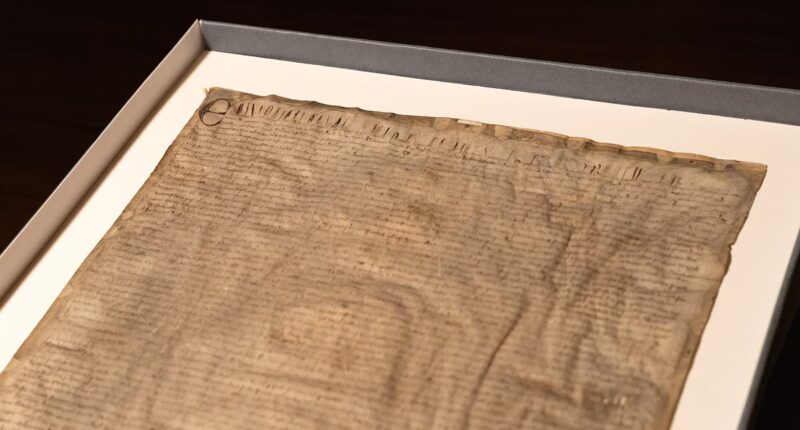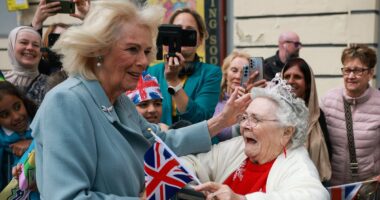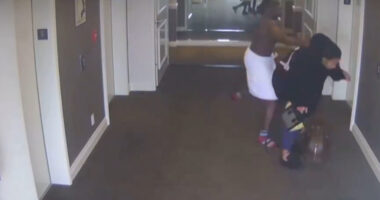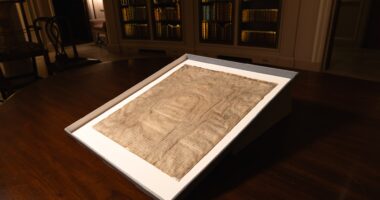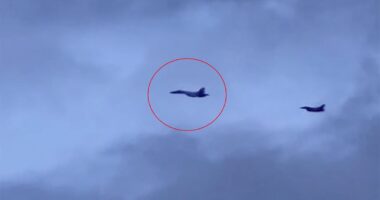A ‘copy’ of the Magna Carta bought by Harvard University for £20 is actually an original worth £16million, scans have showed.
Recently, an examination has revealed that Harvard’s $27.50 auction purchase exhibits handwriting and sizing that align with genuine historical documents, more than 700 years after its creation.
It comes as up until now there were thought to have been just six original copies that remained of the ground-breaking charter.
Originally penned in 1215 by the Archbishop of Canterbury under King John’s authority, the Magna Carta aimed to reconcile the monarch with rebellious barons and is recognized for influencing the frameworks of numerous constitutions globally.
Although the initial iteration was voided, it was later reissued in 1300 by Edward I, affirming safeguards for church privileges, restrictions on levies, and the right to fair and unbiased legal proceedings.
Almost 650 years later in 1946, Harvard University would go on to buy what they thought was an unofficial replica – for $27.50 (£20.73) at auction.
It was described in the auction catalogue as a ‘copy… made in 1327… somewhat rubbed and damp-stained’.
King’s College London and the University of East London have now undertaken new research that has found the handwriting, sizing and elongated letters are all consistent with the original.

A ‘copy’ of the Magna Carta bought by Harvard University for £20 is actually an original worth £16million, scans have showed

The handwriting was also deemed identical – with the large capital ‘E’ at the start in ‘Edwardus’ and elongated letters in the first line

Professor Carpenter and Professor Vincent realised the document’s dimensions – 19.2in by 18.6in – were the same as the six previously known originals
A similar original Magna Carta auctioned in 2007 sold for $21.3million.
David Carpenter, professor of medieval history at King’s College London, called the revelation a ‘fantastic discovery’.
He said: ‘Harvard’s Magna Carta deserves celebration, not as some mere copy, stained and faded, but as an original of one of the most significant documents in world constitutional history, a cornerstone of freedoms past, present and yet to be won.’
The comments come as the four of the document’s clauses, including a guarantee of due legal process, are still in law today.
Professor Carpenter had been studying unofficial copies of the Magna Carta when he came across its digitised version on the Harvard Law School Library website.
Realising it might be an original, he began to compare it to other originals to establish its authenticity.
A fellow professor of medieval history, Nicholas Vincent, of the University of East Anglia, was called upon to help and it was not long before the pair were making some remarkable discoveries.
Professor Carpenter and Professor Vincent realised the document’s dimensions – 19.2in by 18.6in – were the same as the six previously known originals.

Images obtained by Harvard Law School librarians via ultraviolet light and spectral imaging went on to confirm the text matched up perfectly with that of the originals

David Carpenter, professor of medieval history at King’s College London, called the revelation a ‘fantastic discovery’

The pair believe the document may be the lost Magna Carta issued to the former parliamentary borough of Appleby in Westmorland

The manuscript had been sent to auction in 1945 by Air Vice-Marshal Forster ‘Sammy’ Maynard, a First World War pilot who had inherited archives from Thomas and John Clarkson, leading campaigners against the slave trade

The Magna Carta has gone on to form the basis of constitutions around the world and is considered a key step in the evolution of human rights against oppressive rulers
The handwriting was also deemed identical – with the large capital ‘E’ at the start in ‘Edwardus’ and elongated letters in the first line.
Images obtained by Harvard Law School librarians via ultraviolet light and spectral imaging went on to confirm the text matched up perfectly with that of the originals.
Professor Vincent said: ‘If you asked anybody what the most famous single document in the history of the world is, they would probably name Magna Carta. It is an icon both of the Western political tradition and of constitutional law.’
The pair believe the document may be the lost Magna Carta issued to the former parliamentary borough of Appleby in Westmorland.
It comes after the manuscript had been sent to auction in 1945 by Air Vice-Marshal Forster ‘Sammy’ Maynard, a First World War pilot who had inherited archives from Thomas and John Clarkson, leading campaigners against the slave trade.
Clarkson retired to the Lake District in the early 1800s, where he became a friend of the poet William Wordsworth.
The Magna Carta has gone on to form the basis of constitutions around the world and is considered a key step in the evolution of human rights against oppressive rulers.
